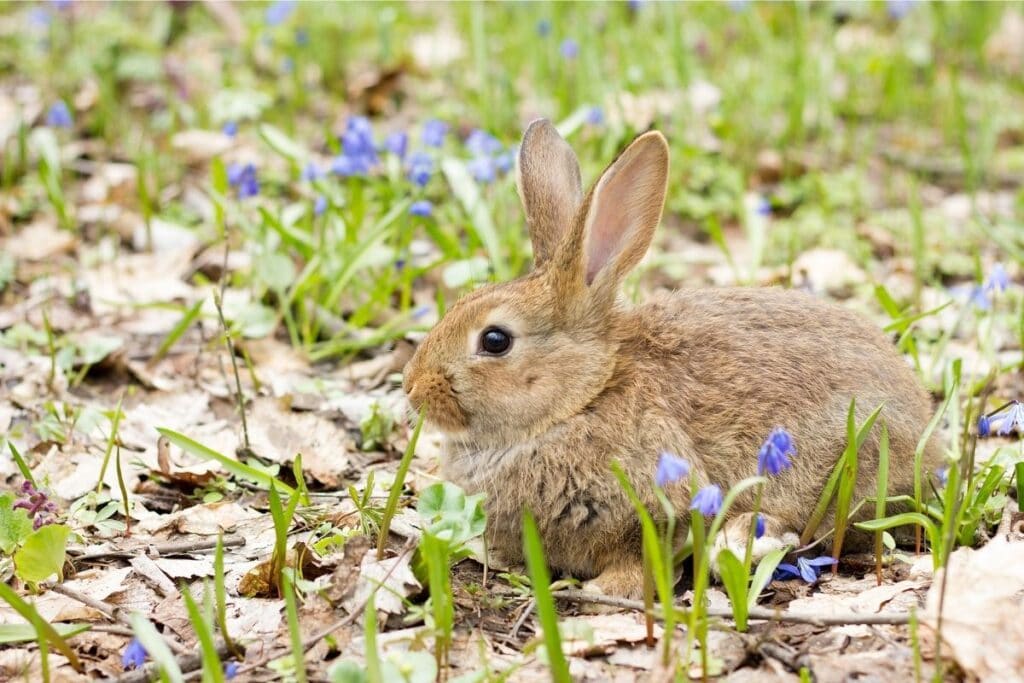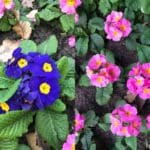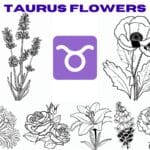Rabbits play an important role in our ecosystem by keeping invasive weeds under control. Rabbits also help to fertilize flowers and vegetable plants, and let’s face it – they’re pretty cute.
However, cute or not, you probably don’t want to see rabbits in your flower beds as they can do heavy amounts of damage in very little time – it’s their job!
To help deter these fuzzy plant-destroyers, consider planting flowers that are not attractive to rabbits.
Although there are very few plants that rabbits refuse to eat, there are some that are less appealing than the grass or weeds that typically grow nearby – meaning your flowers should be spared.
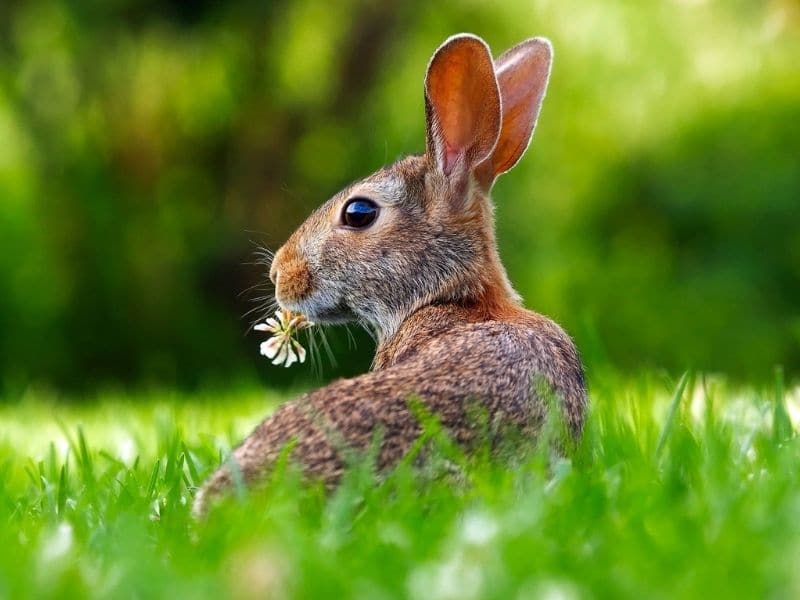
The ideal way to keep your flower garden safe from rabbits is to plant flowers that won’t attract rabbits in the first place. Rabbits will eat nearly any plants, but just like you and me, they have preferences.
Most rabbits enjoy eating everyday weeds and grass and will prefer these plants over some flower types; these are the kinds of flowers you want to plant if you have a rabbit problem.
If you’re wondering what to plant to keep rabbits away, here are the flowers that rabbits won’t eat:
#1. Asters
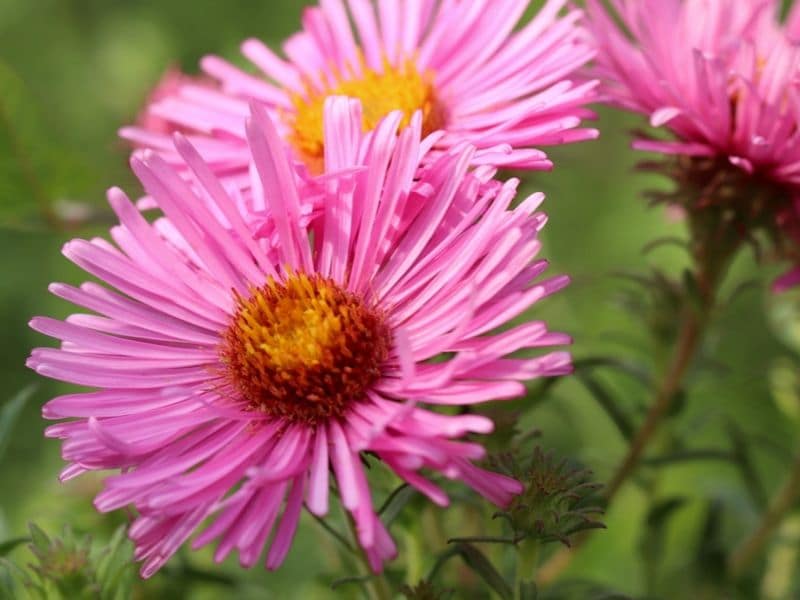
When looking for rabbit-resistant flowers to plant, asters (Symphyotrichum) can be a great choice. While they are not a rabbit’s favorite snack, they do attract butterflies, which are generally a more welcomed addition to the garden.
These flowers are vibrant perennials that come in blue, pink, purple, red, and white. The flower heads have multiple thin petals that generally bloom in late summer into fall.
Asters grow well in USDA hardiness zones three through eight and will come back year after year in these zones if properly cared for.
These flowers do best in full-sun locations, although they can tolerate a partial-shade area as well. Asters are flexible when it comes to location and can adapt well to most soil conditions.
#2. Vinca
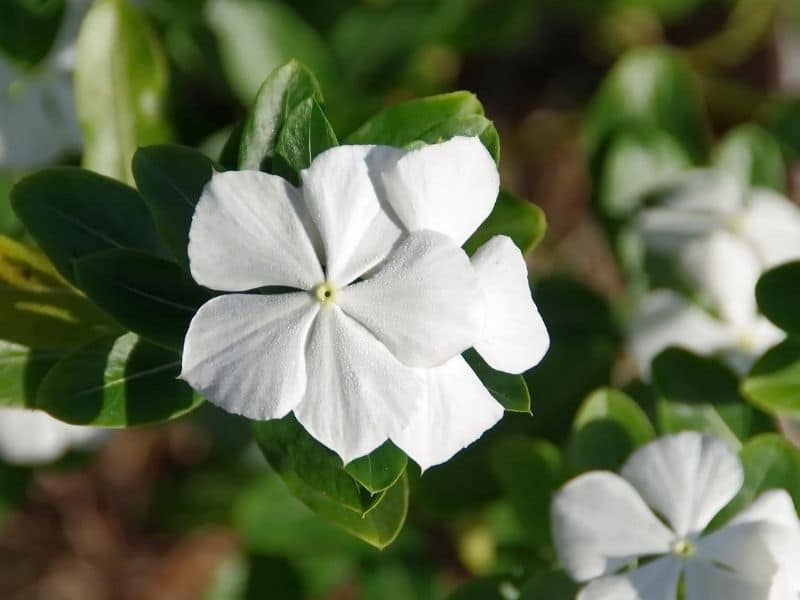
Although they’re not very common, vinca flowers (Catharanthus roseus) are another type of plant that is not generally preferred by rabbits.
Vinca is a perennial ground cover that blooms purple-blue flowers that stand out against its dark green foliage. The foliage is relatively tough for a flowering plant, potentially adding to its rabbit deterrence.
If you want to grow vinca as a perennial, you will need to plant it in USDA hardiness zones four through eight.
The vinca plant is flexible when it comes to sunlight exposure and can be planted anywhere from a full-sun location to a fully shaded one, although flowers will produce the best with more sunlight.
#3. Russian Sage
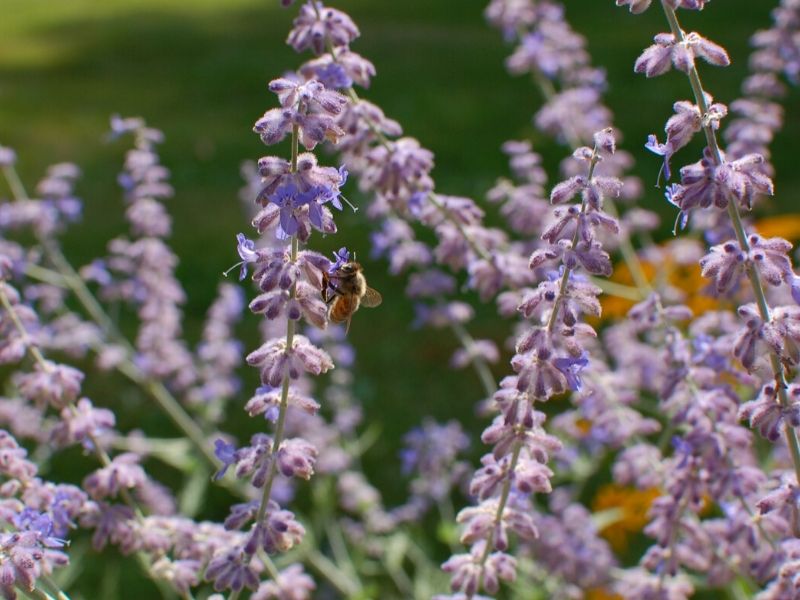
Russian sage (Perovskia atriplicifolia) is another flower that will attract pollinators—such as butterflies—while deterring animals such as rabbits and deer—a win-win situation.
The fragrance that these flowers give off is not appealing to a rabbit; therefore, most rabbits will leave this plant alone even when desperate for a snack. These rabbit resistant perennials grow into tall bushy plants that bloom purple flowers in the late summer.
Russian sage grows as a perennial in zones five through nine. These are a flowering plant that, once established, are truly a hands-off grower.
A full-sun location and well-draining soil are preferred by these plants, but in general, they have very few requirements in order to grow and thrive.
Some will plant Russian sage around their flower gardens or garden beds to deter rabbits from entering the garden at all.
#4. Lilac
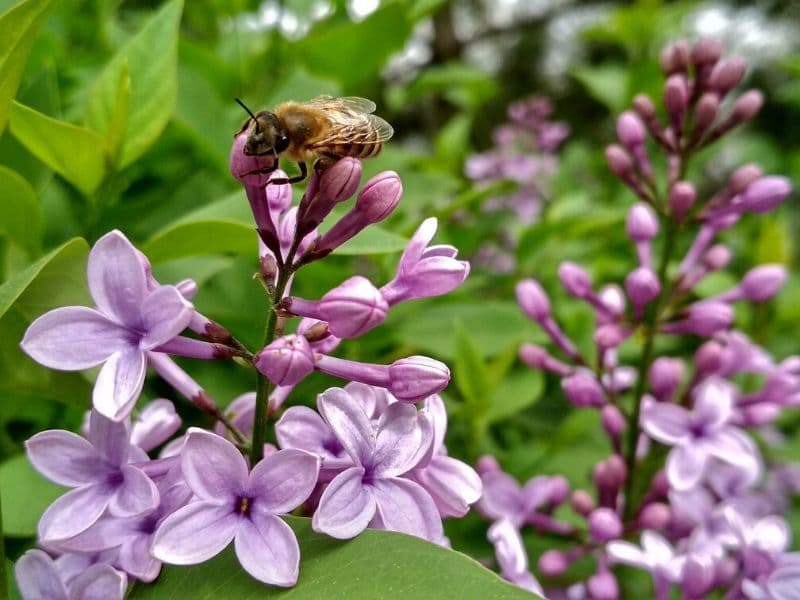
The strong fragrance of lilac flowers (Syringa) comes in handy for deterring mammals such as rabbits from eating and harming the plant—although most of us humans love the scent!
These flowers grow as large shrubs that are often mistaken for bushes. The flowers come in a range of purples which form in clusters, giving the appearance of much larger flowers that are actually many smaller flowers.
Lilac shrubs are perennials in zones four through seven and can grow to be up to ten feet tall in ideal conditions. One drawback of lilac flowers is that they do not have a very long blooming season, meaning their ability to deter rabbits is relatively short.
#5. Black-eyed Susan
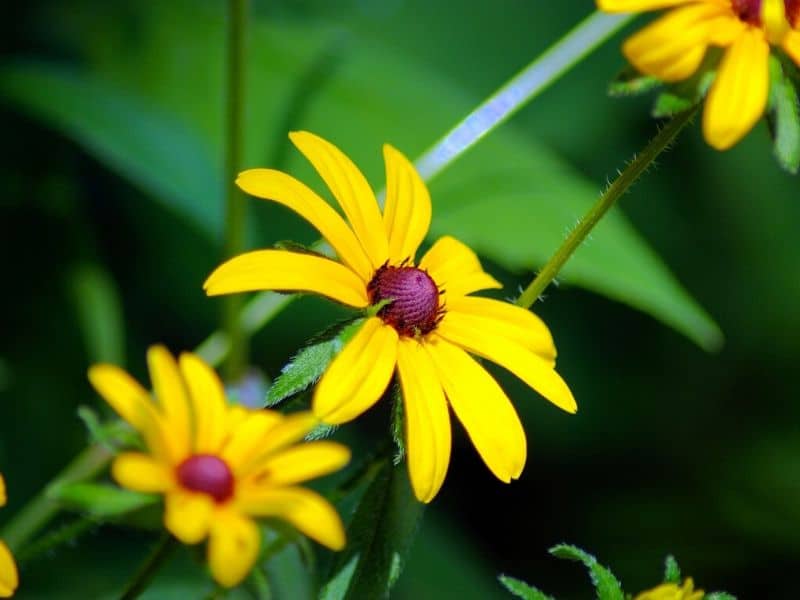
Black-eyed Susans (Rudbeckia hirta) are one of the most common flowers rabbits won’t eat. These rabbit resistant perennials are actually classified as a wildflower and are the most commonly planted wildflower in North America.
When found naturally, Rudbeckia hirta will generally spread themselves across an open field, quickly filling up the prime real estate. This can be an advantage if grown at home because their presence can help deter rabbits from wandering into your garden.
There are both perennial and biennial varieties of black-eyed Susan flowers, and both are effective at deterring rabbits.
Black-eyed Susans can be grown in either full-sun or partial-sun locations, giving you some flexibility on planting locations. These flowers have a fairly large climate reach and will grow best in zones three through nine.
#6. Irises
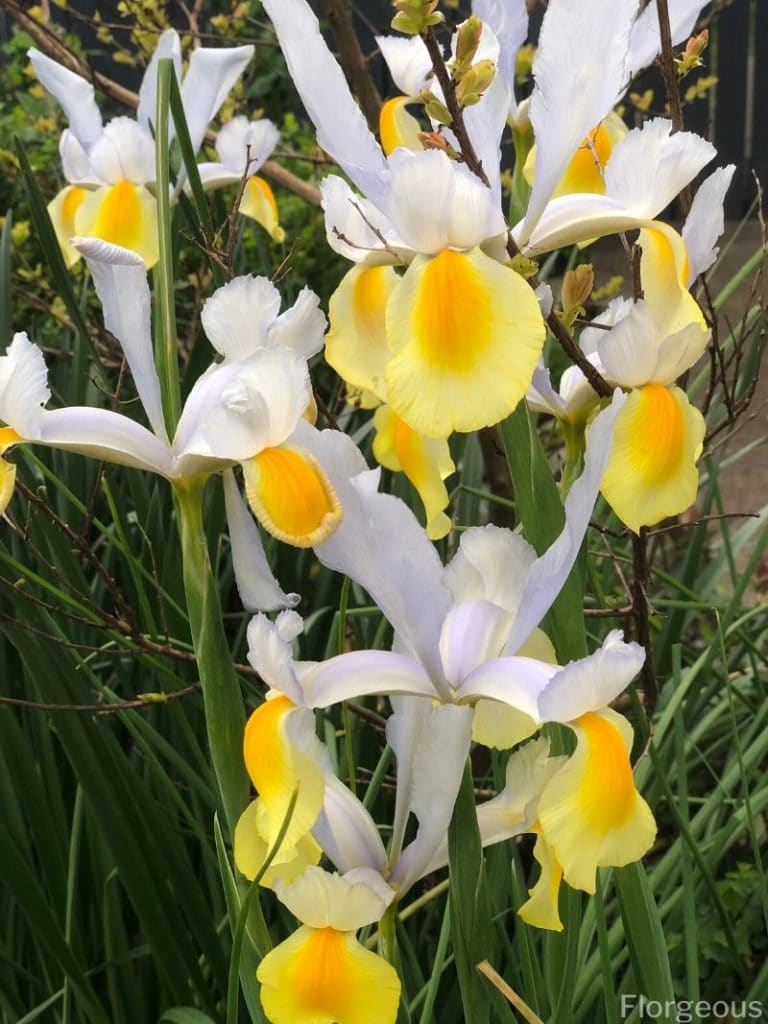
Irises (Iris) are known for their beauty and vibrant colors, but they are also effective at deterring rabbits – an added bonus!
There are more than 300 different species of Irises, and they come in colors such as purple, blue, red, orange, pink, yellow, and even multicolor. Each variety of iris deters rabbits, giving you plenty of options when it comes to which type you would prefer in your garden.
Irises are perennial flowers, so they will come back on their own year after year if cared for properly. These flowers will grow best in USDA hardiness zones three through nine.
Iris flowers are often considered some of the easiest and earliest blooming flowers available on the market! These bulbs bloom first thing in the spring as long as they’re grown in moist soil.
#7. Marigold
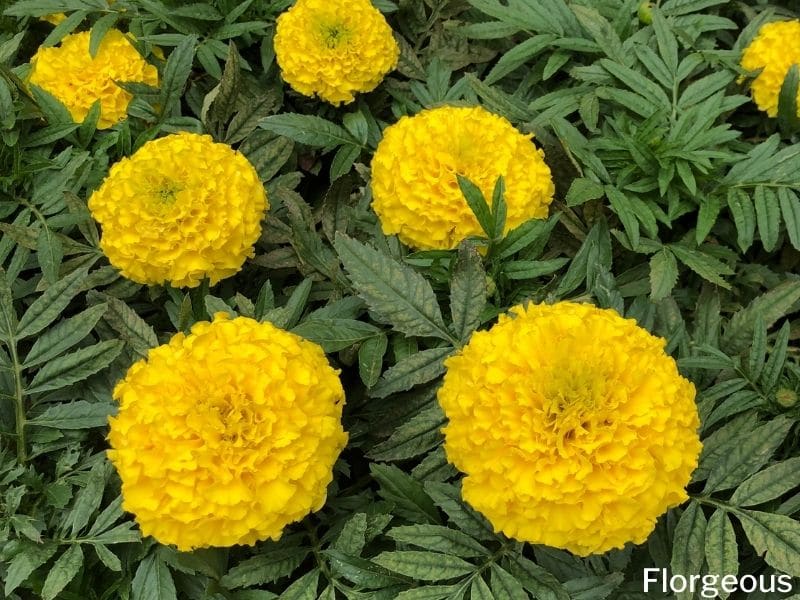
Marigolds (Tagetes) are another flower that, while sure to bring in pollinators, should also be safe from rabbits.
Marigolds bloom some of the brightest flowers in colors such as orange, red, yellow, white, and combinations of these colors. The white flowers are some of the rarest, but most gorgeous!
These blooms are popular due to their ability to blossom all season long, adding to their effectiveness in being rabbit resistant.
Marigolds can be grown in nearly any hardiness zone, three through eleven. In cooler zones, they are primarily grown as an annual, but in warmer zones can come back year after year as a perennial.
Marigolds are a very simple flower to grow and care for, so planting a few to keep the rabbits away may be worthwhile!
#8. Peonies
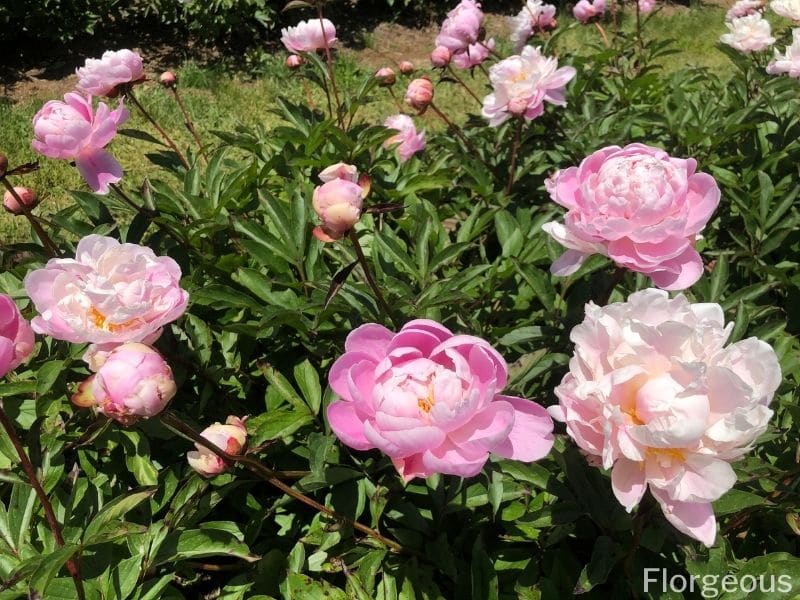
Peonies (Paeonia) are known for their gorgeous flowers with petals that seem to fold within one another, making them full and lush. These flowers will not only add beauty to your garden, but they should be safe from any rabbits that are passing by.
Classic peonies are generally pink, but they also come in purple, red, white, and yellow.
To grow peonies in your garden, you will need to be within USDA hardiness zones three through eight. Peonies are perennials and will continue coming back each season as long as they are cared for well.
Peonies do best in full-sun locations, although they can tolerate partial-shade if needed.
#9. Bleeding Heart
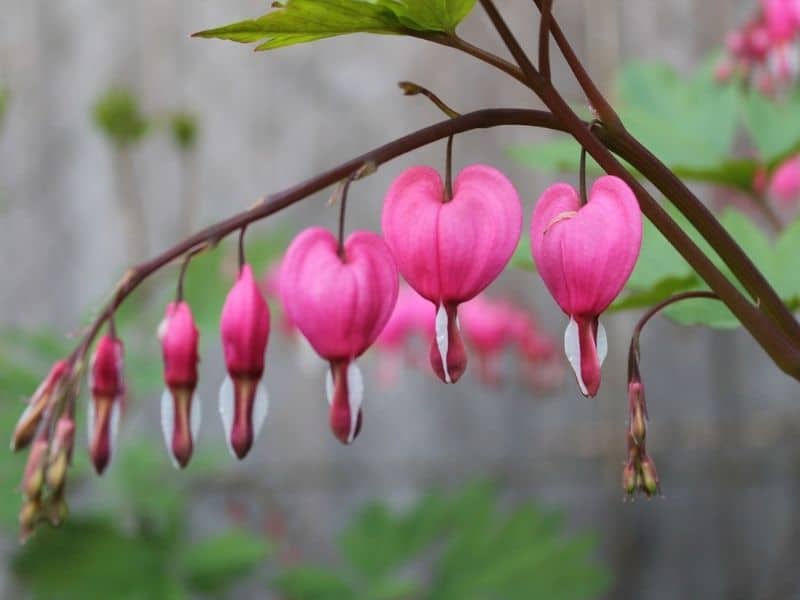
If you’re looking for a more unique flower to plant in your garden that is rabbit-resistant, the bleeding heart (Lamprocapnos) may be for you! These rabbit repellent plants form in the shape of a heart with a tail at the bottom and come in red, pink, and white. These flowers grow side by side along stems that arch out from the plant.
To grow bleeding hearts (sometimes categorized as Dicentra Spectabilis) as a perennial, you need to live within USDA hardiness zones three through nine. Bleeding hearts do best in shady locations, making them a good rabbit-resistant option if you have a shaded flower garden.
Bleeding hearts do a majority of their blooming in the springtime, therefore, they are generally dormant by the time the warm summer months arrive.
#10. Foxglove (Digitalis purpurea)
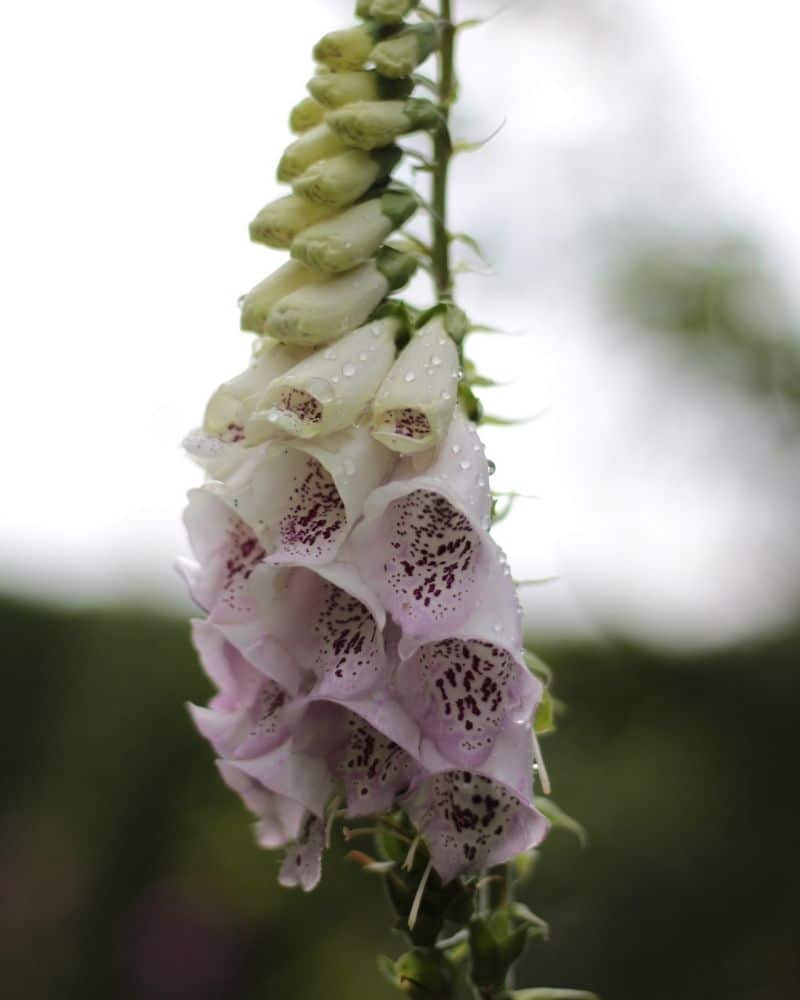
Another unique-looking flower that is generally resistant to rabbits is foxglove (Digitalis purpurea). These flowers form in tube shapes that are approximately the size of fox paws—hence, foxglove. The flowers form in hanging clusters and come in purple, pink, and white colors.
Most varieties of foxglove are biennial, so they will spend the first year growing and will only bloom in their second season. Foxgloves do best in USDA hardiness zones four through nine.
These Digitalis purpurea flowers are a little pickier when it comes to soil type and nutrient content, so they generally grow best in garden beds where the soil can be added and adjusted easily as needed.
11. Coral Bells (Heuchera sp.)
Coral Bells (Heuchera sp.) are a beautiful addition to any garden and come in a wide range of colors. They are a great choice for rabbit-resistant plants because rabbits typically do not like the texture and taste of the tough coral bells leaves.
12. Solomon’s Seal
Solomon’s Seal, also known as Polygonatum, is a hardy plant that is known for its arching stems and delicate white flowers. Rabbits avoid this plant because of its slightly bitter taste.
13. Butterfly Weed (Asclepias tuberosa)
Commonly known as Butterfly Weed, this beautiful plant is perfect for gardens that want to attract both butterflies and hummingbirds. Rabbits, however, tend to avoid Butterfly Weed because of its milky sap, which can be toxic to some animals.
14. Red Hot Poker
Red Hot Poker, also known as Kniphofia, is a plant that produces beautiful spikes of red, orange, and yellow flowers. Rabbits avoid this plant because of its tough texture.
15. Bee Balm
Bee Balm, or Monarda, is a popular plant for attracting bees, butterflies, and hummingbirds due to its sweet nectar. However, rabbits avoid it because of its strong scent.
16. Ornamental Onion
Allium schoenoprasum or chives are a member of the onion family and produce delicate tiny pink or purple flowers on tall stems. Rabbits tend to avoid Ornamental Onion because of its strong scent and flavor.
Ornamental onions can be grown alongside all kinds of other perennials, but avoid planting them near other onions since they’ll attract garden pests.
17. Pachysandra Terminalis
Pachysandra is a low-growing evergreen plant that can add some greenery to your garden. Rabbits typically avoid this plant because of its sticky sap. Moist soil is ideal for these plants, which produce tender foliage in attractive green shades.
18. Eastern Redbud (Cercis Canadensis)
Eastern Redbud is a popular tree that produces beautiful pink or purple flowers in the early spring. Rabbits tend to avoid this plant because of its thick bark.
19. Lamium maculatum
Commonly known as Spotted Dead Nettle, this plant produces bright pink, purple, or white flowers and is perfect for adding color to shady areas of your garden. Rabbits avoid this plant because of its slightly hairy leaves.
20. Salvia sp.
Salvia plants, which are part of the mint family, are known for their fragrant flowers and leaves. Salvia sp, a drought resistant perennial, is also a rabbit resistant plant due to its strong scent and flavor. They’re also great for repelling all kinds of garden pests!
21. Lenten Rose
Hellebores, or Lenten Rose, are a group of perennial plants that produce flowers in shades of pink, white, or green. These plants are rabbit resistant because of their thick stems and tough leaves.
22. Acer Palmatum
Japanese Maple is a small tree that is known for its stunning foliage in shades of red, orange, and yellow. Rabbits tend to avoid this plant because of its thick bark.
23. Hardy Geraniums
Hardy Geraniums, or Cranesbills, are a group of perennial plants that produce flowers in shades of pink, purple, blue, or white. Rabbits tend to avoid these plants because of their slightly hairy leaves.
24. Zinnia elegans
Zinnias are a popular annual plant that produces brightly colored flowers in shades of pink, red, yellow, or orange. Rabbits tend to avoid these plants because of their tough stems and leaves.
Alternatives For Deterring Rabbits
Although there are plenty of rabbit deterrent plants and flowers available to grow, there may be some flowers that you would like to plant that are vulnerable to rabbit munching.
These flowers may actually be at a heightened risk of rabbit damage if you also plant rabbit-resistant flowers in the vicinity, as the rabbits will have less to choose from and may target the non-resistant flowers more heavily.
Rabbits multiply quickly, so it’s important to deter them from eating your desired plants early on. This will encourage them to migrate to areas better suited than your garden for raising their young.
Here are some ways you can deter rabbits from your non-rabbit-resistant garden.
Strong Scents
One of the most common attributes that make a certain flower species undesirable to rabbits is their strong fragrance. Although a faux flower spray might not be strong enough, there are other scents that can be placed or sprayed on or near your plants that may keep rabbits out of your garden.
One of these options is sprinkling red pepper flakes throughout your garden floor. The red pepper flakes may not be strong enough for us to detect, but the rabbits’ strong sense of smell should pick them right up, and—with any luck—keep them away.
Other ideas include garlic or onion spray. These strong scents are sure to be picked up by the noses of any nearby rabbits and encourage them to keep their distance.
Some choose to plant onions around their garden beds as the scent coming from the plants should be strong enough for any rabbits in the vicinity to smell.
Strong Taste
Another option that is similar to strong scents is a strong taste. For this method to work, the rabbits will need to take a sample bite of your flowers, although one bite shouldn’t hurt.
The hope is that only a few curious rabbits will take a bite and will move on, herding the rest of their friends away with them.
A couple of options exist for applying a strong taste to your plants. The first is a cocktail of onion, garlic, and peppers diluted in a water mixture and sprayed on the plants.
This mixture should not cause any damage to the plants, but one bite from a rabbit should be enough to deter these fuzzy creatures.
Another common option is a mixture of Lysol and water that is applied to the plants via a spray. This is another taste that rabbits despise, discouraging any future bites.
Cones
If you don’t want to apply any mixtures to your plants, there is always the option of adding a barrier between your plant stems and the rabbits.
Some gardeners choose to create cones for the base of their plants. These cones can be made of anything including tin cans, mesh fabric, or plastic cones.
Although this will not protect any low-hanging leaves, it will protect the most vital external part of the plant, the base stem.
Humane Traps
If all else fails, there is always the option of trapping and relocating the rabbits to another location – preferably one where they won’t be a nuisance to anyone else. Trapping and moving rabbits are best accomplished before the population gets out of control – if you can help it.
Rabbits repopulate quickly, and there is a big difference between catching and moving a few rabbits and catching and moving a few dozen rabbits as well as trying to get rid of rabbits.
The Best Way to Repel Rabbits?
While the alternatives listed above can be used for serious rabbit problems, your best bet is to grow plants that are resistant. This will help you create a natural rabbit barrier without having to worry about other side effects caused by using traps or chemicals.
Grow a few of these rabbit-resistant flowers, and you won’t have to worry about any unwanted visitors stopping by for a nibble!
Up next:
*image by light-violet-foxgloves/depositphotos

